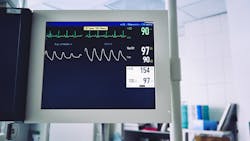Reduced hospital costs using continuous pulse oximetry and capnography monitoring of high-risk patients
Medtronic plc announced the publication of an economic model based on data from the PRODIGY trial, PRediction of Opioid-induced respiratory Depression In patients monitored by capnoGraphY, that demonstrates shorter patient stays and reduced hospital costs associated with continuous pulse oximetry and capnography monitoring for patients receiving opioids on medical-surgical units when compared to intermittent pulse oximetry alone.
According to study findings, continuous capnography and pulse oximetry monitoring of high-risk patients who are receiving opioids could result in $535,531 annual hospital cost savings for a median-sized U.S. hospital and a cumulative patient length of stay decrease of 103 days per year, assuming respiratory depression is decreased by 20%.
Pulse oximetry is a simple, noninvasive bedside technology that can accurately measure changes in arterial blood oxygen saturation and pulse rate. Capnography measures exhaled carbon dioxide during the respiration cycle as well as respiratory rate.
Published online in Advances in Therapy, the analysis was based primarily on data from the PRODIGY trial. PRODIGY is a Medtronic-sponsored, prospective observational, multi-center study conducted to quantify the incidence of and identify patients at high risk for opioid-induced respiratory depression (OIRD), a potentially life-threatening form of respiratory compromise (RC) that reduces the patient's drive to breathe.
"Although respiratory depression occurs in 46% of patients receiving opioids on the general care floor, the cost-benefit of capnography and oximetry for continuous monitoring of patients had not yet been examined," said Ashish K. Khanna, M.D., primary study investigator and an associate professor of Anesthesiology, vice-chair for Research, and intensivist at the Wake Forest School of Medicine. "Our findings suggest that compared to intermittent monitoring, investing in continuous monitoring of high-risk patients receiving opioids could reduce the cost burden and length of patient stay while potentially increasing patient safety. Our model suggests that a mere reduction of 1.5% in the incidence of respiratory depression would allow hospital systems to recover costs associated with the investment in monitoring. The expected reduction from deployment of continuous monitoring on hospital floors is way more."
The economic model was designed using a decision tree framework simulating costs and outcomes of continuous Nellcor pulse oximetry and Microstream capnography monitoring versus intermittent pulse oximetry monitoring* for patients at high risk, high and intermediate risk, and any risk of respiratory depression based on their PRODIGY score. The score was derived from five independent patient characteristics — age, gender, sleep-disordered breathing, opioid naivety, and chronic heart failure. The model applied the results of the PRODIGY study to a hypothetical median-sized U.S. hospital with 2,447 patients receiving opioids on a medical surgical floor in a given year.
Additionally, the primary objective of the PRODIGY trial was to develop and validate a risk stratification tool to assist clinicians in the identification of high-risk patients receiving opioids. The PRODIGY risk stratification tool may support the recent updates from The Joint Commission on monitoring of post-operative patients receiving opioids with the requirement of putting in place a mechanism to identify high risk patients.
